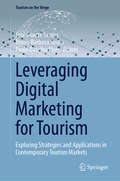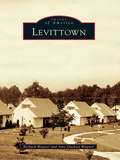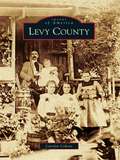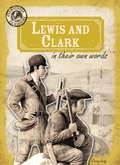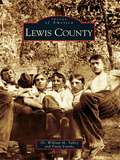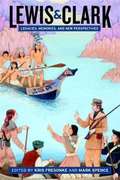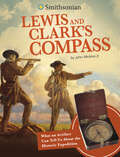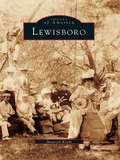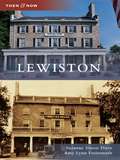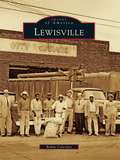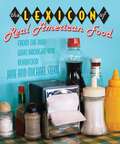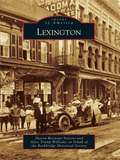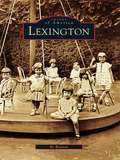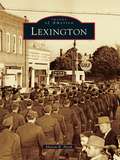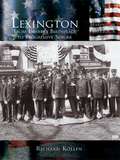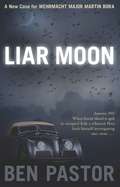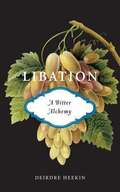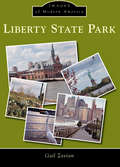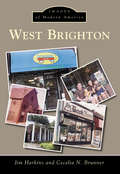- Table View
- List View
Leveraging Digital Marketing for Tourism: Exploring Strategies and Applications in Contemporary Tourism Markets (Tourism on the Verge)
by Bruno Barbosa Sousa José Duarte Santos Paulo Botelho PiresThis edited volume invites readers to explore the convergence of tourism and digital marketing. It navigates the intricate relationship between these two domains by elucidating the role of digital marketing across various facets of the tourism industry. Each chapter offers a blend of theoretical foundations and practical insights, delving into typologies of tourism, specific segments of tourists, and critical sectors essential to tourism's functionality. Through neutral, third-person narration, the volume presents a comprehensive examination, showcasing how digital marketing strategies are applied within diverse tourism contexts. Rich with examples illustrating theory in practice, this work serves as an essential resource for scholars, researchers, and professionals seeking a deeper understanding of this evolving landscape.
Levittown (Images of America)
by Richard Wagner Amy Duckett WagnerIn 1951, Levittown was created in Bucks County outside of Philadelphia by builder pioneers Levitt and Sons. Dubbed the largest and "most perfectly planned" community in America, it featured single-family homes, schools, churches, shopping centers, and swimming pools. A symbol of the "American Dream," Levittown defined the phenomenon of post-World War II suburban developments, which for the first time gave working- and middle-class families the option of affordable, detached houses outside congested urban neighborhoods. Levittown was a melting pot, attracting people from cities, rural areas, and all walks of life, including many World War II veterans with young families. Houses came fully equipped with appliances and landscaping and started at $9,000. Levittown's superb collection of history and photographs illustrates the birth and growth of this unique area, explores the community that resulted, and features residents' personal memories of the golden years.
Levy County
by Carolyn CohensLevy County was founded in 1845 and was named after Florida's first senator, David Levy Yulee. Levy County is a visitor's paradise with the small island of Cedar Key's romantic charm, shops, restaurants, festivals, and art galleries, as well as Chiefland's Train Depot Museum, Suwannee Valley Theater, Watermelon Festival, Christmas Parade of Lights, and Williston Peanut Festival. The woods of Levy County are a sportsman's paradise for hunting and fishing, and divers come from near and far to explore and enjoy the underwater caves of Manatee Springs Park.
Lewis And Clark In Their Own Words
by Janey LevyThe journey of Meriwether Lewis and William Clark across the newly acquired Louisiana Territory from 1804 to 1806 was truly extraordinary. It's best explained using the journals of these two explorers. In this book, primary source materials were carefully chosen to highlight the most interesting and exciting parts of the adventure. An Eyewitness to History book.
Lewis County (Images of America)
by Paula Franke Dr William TalleyLewis County, located in far northeastern Kentucky, was formed in 1806 and named for explorer Meriwether Lewis. The county was once teeming with industry as a supplier of finished goods and agricultural products. Historically, the county's proximity to the Ohio River allowed the export oftimber and salt, and in the 1800s, railroad transportation made Lewis County an influential source of railroad ties, boat-building materials, and barrels. In later years, the area was most popular for its health resorts, spas, and "sulfur waters," which attracted visitors from as far as New York and Chicago. The images in this volume depict the county's military influence, as Lewis Countians had strong allegiance to the Union during the Civil War. The photographs featured in Images of America: Lewis County have been drawn from the archive of the Vanceburg DepotMuseum and from various private collections.
Lewis and Clark Among the Indians
by James P. RondaThe Lewis and Clark expedition has long symbolized the westering impulse in American life. No other exploring party has so fully captured the imagination of ordinary citizens or the attention of scholars. In ways that defy rational explanation, the picture of Lewis and Clark struggling up the Missouri and across the mountains to the great western sea continues to stir our national consciousness. Books, highway markers, museum displays, and a foundation dedicated to preserving the Lewis and Clark trail all bear witness to a fascination that time has only deepened. Over the generations since the expedition returned from the Pacific, its achievement and significance for America heading west have undergone constant reappraisal. From an early emphasis on the journey as an epic of physical endurance and courage, Lewis and Clark have emerged in this century as pioneer western naturalists, cartographers, and diplomats. Thomas Jefferson, the man William Clark once called "that great Character the Main Spring" of the expedition, would have heartily endorsed an evaluation of the Corps of Discovery that included sharp minds as well as strong bodies. And Jefferson would have reminded us that his explorers were part of that long encounter between Euro-Americans and native Americans. In its daily affairs and official actions, the expedition passed through, changed, and was in turn changed by countless native lives. In the simplest terms, this book is about what happens when people from different cultural persuasions meet and deal with each other. The Lewis and Clark expedition was an integral and symbolic part of what James Axtell has aptly called "the American encounter." Nearly two and a half years of almost constant contact between explorers and Indians illuminate the larger and longer series of cultural relationships that began centuries before on the margins of the continent. This book is not a retelling of the familiar Lewis and Clark adventure. That story has been told with grace and skill by Bernard DeVoto and in the magnificent photographs of Ingvard Eide and David Muench. But readers will find moments of high drama not previously well known or clearly understood.
Lewis and Clark for Kids: Their Journey of Discovery with 21 Activities (For Kids series)
by Janis HerbertJoin Meriwether Lewis and William Clark's Corps of Discovery as they navigate the muddy Missouri River and begin a great adventure set against the background of the vast North American continent. Lewis and Clark for Kids takes children from President Jefferson's vision of an exploratory mission across a continent full of unique plants and animals through their dangerous and challenging journey into the unknown to the expedition's triumphant return to the frontier town of St. Louis. Twenty-one activities bring to life the Native American tribes they encountered, the plants and animals they discovered, and the camping and navigating techniques they used. A glossary of terms and listings of Lewis and Clark sites, museums, and related Web sites round out this comprehensive activity book.
Lewis and Clark: Legacies, Memories, and New Perspectives
by Mark David Spence Kris FresonkeAn interdisciplinary collection of essays that explores the legacy of the Lewis and Clark Expedition, and offers new perspectives on these American icons.
Lewis and Clark’s Compass: What an Artifact Can Tell Us About the Historic Expedition (Smithsonian Artifacts from the American Past)
by John Micklos Jr.The Louisiana Purchase in 1803 nearly doubled the size of the United States. The U.S. suddenly went from consisting of 17 states along the Atlantic coast to claiming land as far west as present-day Montana. The U.S. government knew little about the terrain there. Was there a water route to the Pacific? President Thomas Jefferson sent William Clark and Meriwether Lewis to find out. With nothing to guide them but a compass, what would Lewis and Clark discover? Readers will find the answer to this question and how an artifact can tell us about U.S. history.
Lewisboro
by Maureen KoehlThe history of a town is found in the faces of its people and the places familiar to them. It is the story of the families that lived, worked, and played together over the years. With Lewisboro, the reader is invited to take a fascinating step back in time to view the history of this Westchester County town as it unfolds. The town is divided into six hamlets that are each proud of their unique heritage: Vista, Lewisboro, South Salem, Waccabuc, Cross River, and Goldens Bridge. Primarily a rural farm community in the nineteenth and early twentieth centuries, the introduction of the New York City Reservoir System and improved highways changed Lewisboro in many ways. Its lakes became lake communities offering affordable vacation homes; its farms became neighborhoods; and the railroad made commuting a way of life. Slowly the town grew.
Lewiston
by Amy Lynn Freiermuth Suzanne Simon DietzLewiston, New York, a village and town on the mighty Niagara River, was destroyed during the War of 1812. Rebuilding began in the embers from that war, and the ongoing transformation has created a popular tourist destination for music, theater, festivals, and more. Historian Suzanne Simon Dietz and photographer Amy Lynn Freiermuth combined their talents to create Lewiston by selecting images from local museums, libraries, newspaper archives, and private collections.
Lewisville (Images of America)
by Robin Cole-JettOriginally known as Holford's Prairie, Lewisville's name is not the only thing that has changed about this town in its long history. Settlers sponsored by the Peters Colony Company founded the small community in the 1840s. In the ensuing years, the settlement, renamed to Lewisville by Basdeal W. Lewis in 1856, consistently grew and prospered until its incorporation in 1925. Cotton farming and ginning, the arrival of the Dallas and Wichita Railroad in 1881, the expansion of Lake Dallas into Lake Lewisville in 1954, and the opening of the Dallas/Fort Worth International Airport in 1974 ensured that Lewisville became an important commercial center in booming North Texas. Throughout its phenomenal growth, however, Lewisville still retained the charm and bonds of its farm-centered past. Today Lewisville boasts the largest population and school district in Denton County and serves as a suburb for the bustling Dallas/Fort Worth Metroplex.
Lexicon of Real American Food
by Jane Stern Michael SternFor foodies, wordsmiths, and anyone who loves to eat, an illustrated guide to authentic American fare, from the beloved Roadfood teamIn linguistics, the lexicon of a language is its vocabulary, including its words and expressions. In The Lexicon of Real American Food, renowned foodies Jane and Michael Stern record the lingo of American food as it is spoken—and enjoyed—across the nation. With their signature wit and exuberance, they define how America really eats—to the delight of food lovers and word aficionados everywhere. Fun to read and easy to browse, with spot illustrations and select recipes, this book will also become a valuable reference to document regional specialties and signature American fare. Since the first edition in their Roadfood series in 1978, the Sterns have reported on more than 100,000 meals at America’s tables and cafe counters alongside people of every stripe; and in doing so they have gained an unequalled sense of real American food. Thus, the food described in these pages is democratic, not elitist—from hoppel-poppel to puffy tacos, The Sterns see the nation’s diet like its language: endlessly, endearingly exuberant. Their Lexicon of Real American Food inspires a new and joyful appreciation of our country’s irrepressible foodways.
Lexington
by Rockbridge Historical Society Sharon Ritenour Stevens Alice Trump WilliamsLexington, the seat for Rockbridge County, is situated in the beautiful Shenandoah Valley within minutes of the Blue Ridge Mountains. Main Street is part of Route 11--the Valley Pike/Great Road--and the architecture downtown looks much as it did in the 19th century. Lexington is home to Washington and Lee University and Virginia Military Institute. It is also the final resting place for Thomas "Stonewall" Jackson and Robert E. Lee, as well as their horses. Within a few blocks, one visits the Stonewall Jackson House, Lee Chapel Museum, the VMI Museum, and the George C. Marshall Library Museum.
Lexington
by Bo BennettLexington, North Carolina, heralded as the "Barbecue Capital of the World," is located in the heart of the Triad, just 30 miles from High Point, Winston-Salem, and Greensboro. Along with barbecue, the town enjoys a rich history in the furniture business and textile industry. Legend claims that the European families who made Lexington their home in the early 1700s named it after a battle of the American Revolution. On April 19, 1775, the brave soldiers of Lexington, Massachusetts, armed themselves and courageously fought the British, losing seven American lives. News of their courage reached North Carolina, and it was decided to name the town in honor of the place whereone of the first known British resistances occurred.
Lexington
by Sharon R. PaethOriginally known as Saxe Gotha Township when it was created by the Colonial government in 1735, Lexington has a unique and rich history. The county began simply as a buffer between the city of Charleston and the Native Americans. Creative locals built a thriving business community in the area around the Congaree River in present-day Cayce, supporting trade between the colonists and the Native Americans. Emigrants from Germany and Switzerland were invited to become pioneers. They were independent, hard-working farmers who built the area into a strong and sustaining home despite numerous trials and tribulations. Native American wars, fires, Civil War, depressions, and world wars only solidified these settlers' strong sense of ownership and pride in their county. Today visitors enjoy over 50 historical sites and recreation facilities.
Lexington: From Liberty's Birthplace to Progressive Suburb
by Richard KollenA quiet colonial town forever changed by the shot heard 'round the world on April 19, 1775, Lexington evolved from its famous roots and adapted to the ever-changing culture of the nation it helped create. Over the centuries, an influx of immigrants and new ideas helped shape the town from farming community to booming rail suburb and into today's diverse city that treasures its rich heritage while striving toward a dynamic future.
Liar Moon
by Ben PastorPraise for Ben Pastor's Lumen: "Pastor's plot is well crafted, her prose sharp. . . . A disturbing mix of detection and reflection."--Publishers Weekly "Rivets the reader with its twist of historical realities. A historical piece, it faithfully reproduces the grim canvas of war. A character study, it captures the thoughts and actions of real people, not stereotypes."--The Free Lance-Star "And don't miss Lumen by Ben Pastor. . . . An interesting, original, and melancholy tale."--Literary Review Italy, September 1943. The Italian government switches sides and declares war on Germany. The north of Italy is controlled by the fascist puppets of Germany; the south liberated by Allied forces fighting their way up the peninsula. Having survived hell on the Russian front, Wehrmacht major and aristocrat Baron Martin von Bora is sent to Verona. He is ordered to investigate the murder of a prominent local fascist: a bizarre death threatening to discredit the regime's public image. The prime suspect is the victim's twenty-eight-year-old widow Clara. Haunted by his record of opposition to SS policies in Russia, Bora must watch his step. Against the backdrop of relentless anti-partisan warfare and the tragedy of the Holocaust, a breathless chase begins. Ben Pastor, born and now back in Italy, lived for thirty years in the United States, working as a university professor in Vermont. The first in the Martin Bora series, Lumen, was published by Bitter Lemon Press in May 2011.
Liars & Legends: The Weirdest, Strangest, and Most Interesting Stories from the South
by Emily EllisonEveryone loves a good story. And Liars and Legends contains 40 of the South's most interesting and . . . well . . . just plain curious stories. This book grows out of the popular Turner South television show, Liars and Legends and will be promoted on the show.
Libation
by Deirdre HeekinFor many years, Deirdre Heekin has been creating an unusual, revitalist wine archive of rare and traditional Italian varietals at Osteria Pane e Salute, the nationally celebrated restaurant and wine bar she shares with her chef husband, Caleb Barber. Self-taught in the world of Italian wines, she is known for her fine-tuned work with scent and taste and her ability to pair wines and food in unexpected yet terroir-driven ways. InLibation, a Bitter Alchemy,, a series of linked personal essays, Heekin explores the curious development of her nose and palate, her intuitive education and relationship with wine and spirits, and her arduous attempts to make liqueurs and wine from the fruits of her own land in northern New England. The essays follow her as she unearths ruby-toned wines given up by the ghosts of long-gone wine makers from the red soil of Italy, her adoptive land; as she embarks on a complicated pilgrimage to the home of one of the world's oldest cocktails, Sazerac, in Katrina-soaked New Orleans; as she attempts a midsummer crafting of a brandy made from inherited roses, the results of an old Sicilian recipe she found in a dusty bookstore in Naples. Musing on spirits from Campari to alkermes, Heekin's writing is as intoxicating, rich, and carefully crafted as the wines, liquors, and locales she loves.
Liberty
by Jakob EjersboTwo young men from very different backgrounds.Christian is the son of Danish ex-pats; Marcus works as a house boy for a Swedish family, hoping they will eventually take him back to Europe with them.Their friendship defines a divided continent.When they decide to go into business together--a teenage dream of playing at discos--they unwittingly set a collision course. But will it be love or money that tears the two apart?Spanning a decade from the dawn of the 1980s, the story of Marcus and Christian's dissolving friendship plays out amid a vast cast of characters, all fighting to make their way in a country defined by corruption. As the Tanzanian authorities and European aid agencies compete to line their own pockets, the rise of 'the disease' threatens to lay waste to an already stricken continent.
Liberty
by Jakob EjersboThe novel behind the new Danish TV series starring The Killing's Sofie Gråbøl, available on All 4 / Walter PresentsTwo young men from very different backgrounds.Christian is the son of Danish ex-pats; Marcus works as a house boy for a Swedish family, hoping they will eventually take him back to Europe with them. Their friendship defines a divided continent.When they decide to go into business together - a teenage dream of playing at discos - they unwittingly set a collision course. But will it be love or money that tears the two apart? Spanning a decade from the dawn of the 1980s, the story of Marcus and Christian's dissolving friendship plays out amid a vast cast of characters, all fighting to make their way in a country defined by corruption. As the Tanzanian authorities and European aid agencies compete to line their own pockets, the rise of 'the disease' threatens to lay waste to an already stricken continent.
Liberty (The Africa Trilogy)
by Jakob EjersboThe novel behind the new Danish TV series starring The Killing's Sofie Gråbøl, available on All 4 / Walter PresentsTwo young men from very different backgrounds. Christian is the son of Danish ex-pats; Marcus works as a house boy for a Swedish family, hoping they will eventually take him back to Europe with them. Their friendship defines a divided continent. When they decide to go into business together - a teenage dream of playing at discos - they unwittingly set a collision course. But will it be love or money that tears the two apart? Spanning a decade from the dawn of the 1980s, the story of Marcus and Christian's dissolving friendship plays out amid a vast cast of characters, all fighting to make their way in a country defined by corruption. As the Tanzanian authorities and European aid agencies compete to line their own pockets, the rise of 'the disease' threatens to lay waste to an already stricken continent.
Liberty State Park (Images of Modern America)
by Gail ZavianSituated on the Hudson River, the Central Railroad of New Jersey terminal operated its railroad/maritime complex for over 100 years in this area. After its shutdown in 1967, community advocates, already lobbying for nine years, continued their successful campaign for the site to become a public park. With over 1,000 acres, Liberty State Park opened on Flag Day--June 14, 1976. Today, this recreational landscape features the Nature Interpretive Center, Liberty Science Center, and a section of the Hudson River Waterfront Walkway. Liberty State Park, in Jersey City, is the only place in New Jersey where one can board a ferry to visit Ellis Island and the Statue of Liberty. Liberty State Park showcases the rich cultural and environmental history of this landscape's transformation from an abandoned waterfront transportation hub into one of America's most exceptional state parks.
Liberty State Park (Images of Modern America)
by Gail ZavianSituated on the Hudson River, the Central Railroad of New Jersey terminal operated its railroad/maritime complex for over 100 years in this area. After its shutdown in 1967, community advocates, already lobbying for nine years, continued their successful campaign for the site to become a public park. With over 1,000 acres, Liberty State Park opened on Flag Day--June 14, 1976. Today, this recreational landscape features the Nature Interpretive Center, Liberty Science Center, and a section of the Hudson River Waterfront Walkway. Liberty State Park, in Jersey City, is the only place in New Jersey where one can board a ferry to visit Ellis Island and the Statue of Liberty. Liberty State Park showcases the rich cultural and environmental history of this landscape's transformation from an abandoned waterfront transportation hub into one of America's most exceptional state parks.
